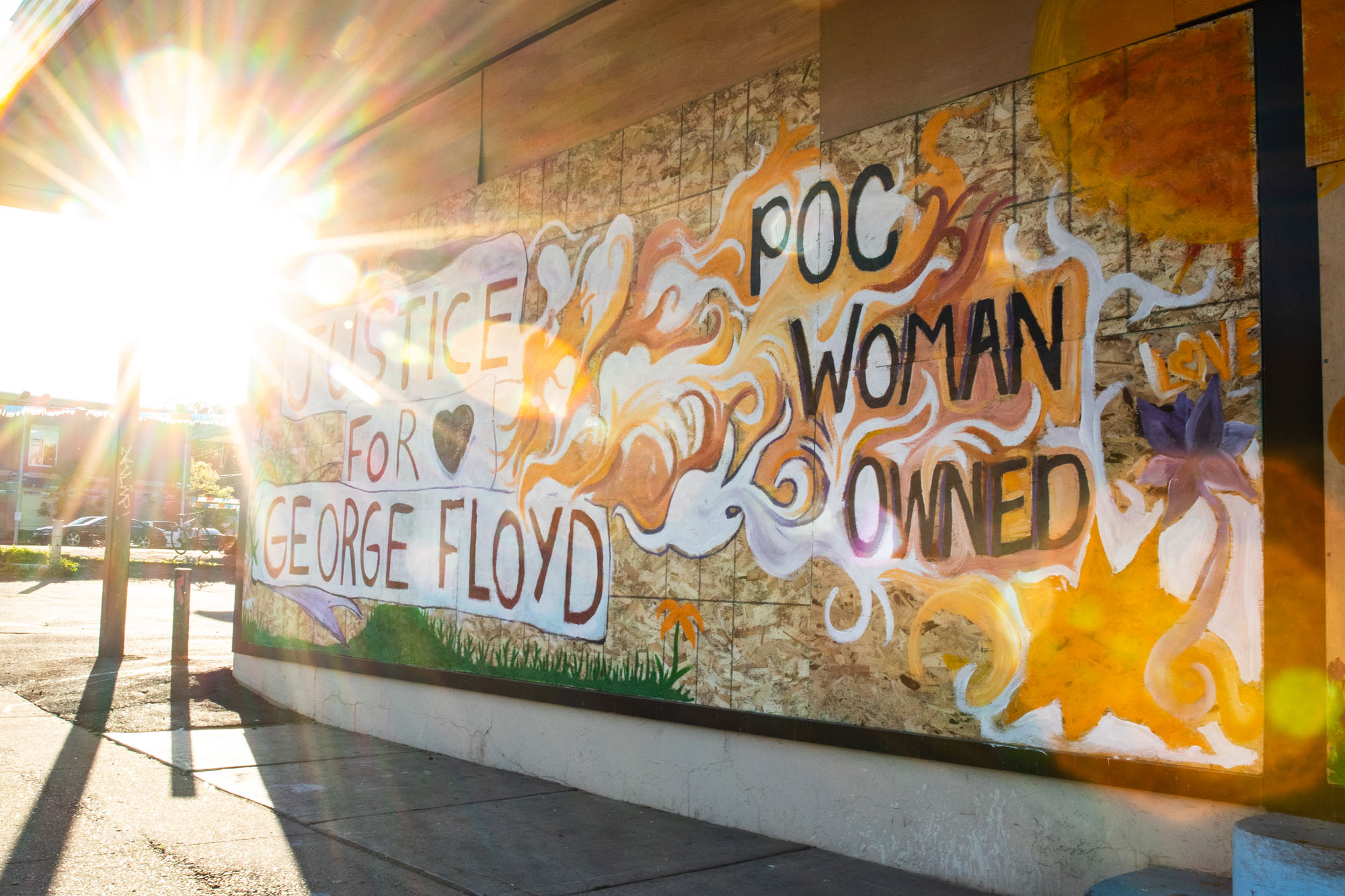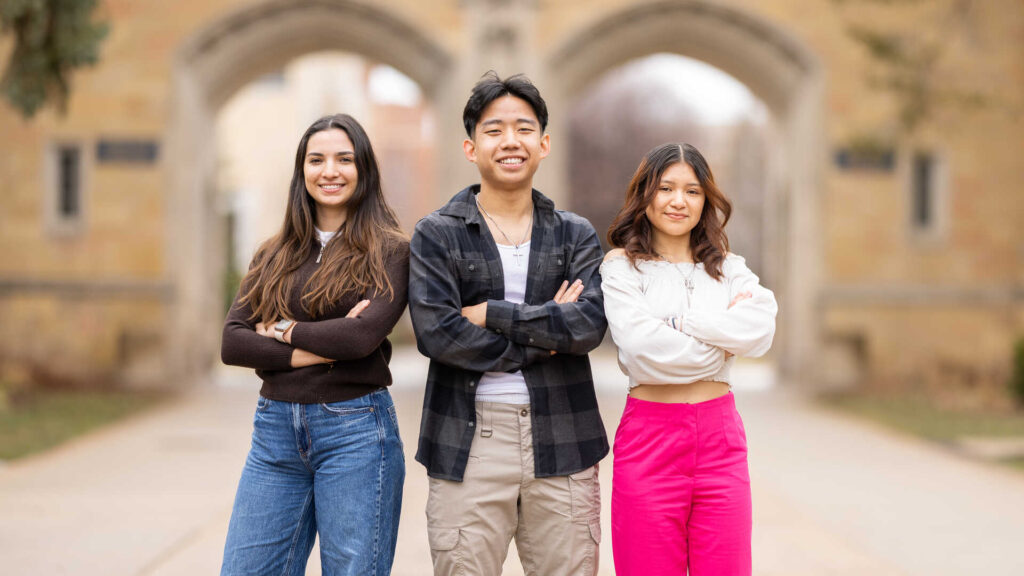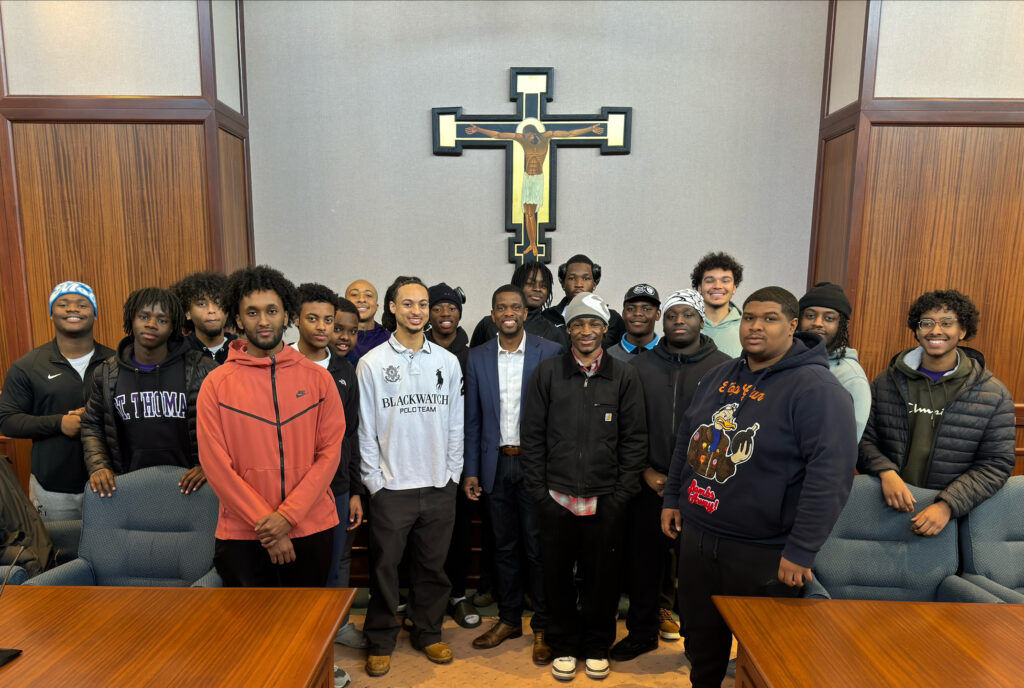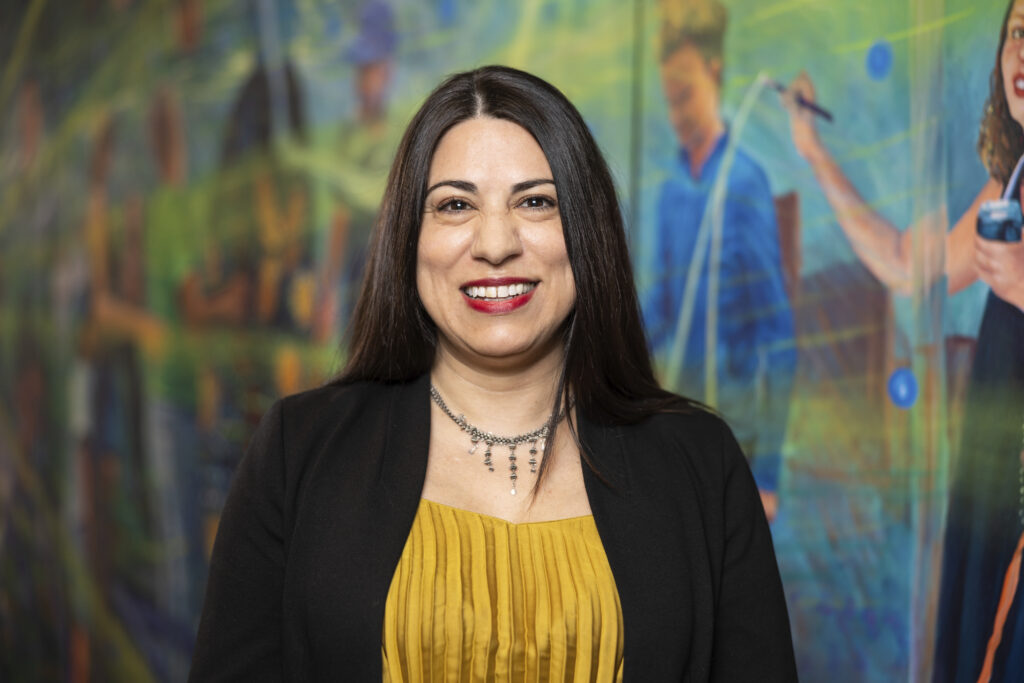The killing of George Floyd in Minneapolis has reverberated across the world with people taking to the streets to protest police brutality and systemic racism. In the aftermath of Floyd’s death, folks have found various ways to express their feelings, including artists of all abilities who’ve created murals, paintings on boarded-up storefronts and even drawings on the pavement near where Floyd died, which has now become a memorial site.
A St. Thomas group is working to ensure the art created during this vital moment in history isn’t forgotten. College of Arts and Sciences associate professors Todd Lawrence (English), Paul Lorah (Geography) and Heather Shirey (Art History) run the Urban Art Mapping Research Project. Students serve as research collaborators: senior Tiaryn Daniels and recent graduates Hannah Shogren-Smith ’20, and Chioma Uwagwu ’20.

From left, Professors Todd Lawrence (English) Paul Lorah (Geography) and Heather Shirey (Art History).
The Urban Art Mapping Research Project operates a George Floyd and Anti-Racist Street Art database, which documents examples of street art from around the world that have emerged since Floyd’s killing as part of an ongoing movement demanding social justice and equality. (The group is crowdsourcing submissions of any art relating to this matter.)
The database serves as a repository for images and a future resource for scholars and artists. The project makes possible an analysis of the themes and issues that appear in street art, that can be explored in relation to local experiences, responses and attitudes.
“Oppression is a global issue. It's not just here in Minnesota,” Shirey said. “I'm not surprised to see this appear in street art throughout the world. What's been surprising and cool to see is how crowdsourcing has spread worldwide so quickly. We had a submission from the wall between Israel and Palestine in Bethlehem. There was a beautiful George Floyd piece on that wall. Seeing this call for change on the wall – to see that popping up all over the world has been amazing.”
The database is a way to remember this pivotal moment in time, said Lawrence.
“This is an important cultural moment, a historical moment,” Lawrence said. “And this is one way to preserve some of the communication around that, some of the cultural production inspired by the moment, and keep it in a place people can come back and look at it for as long as the computers are running. This is a way we’ll be able to revisit this moment and continue to think about what’s important.”
Capturing the moment
The raw emotion captured in street art created in the days immediately following Floyd’s death is important for the group to document, but, unfortunately, much of it is disappearing before they’re able to get to it. Plywood is being removed and disposed of, building graffiti is being painted over and new murals have been created to cover some pieces as neighborhoods clean up. That’s why public submissions to the database are significant.
“There are going to be people who will want to look back on this five years from now and think, look at how positive this was and how we all came together,” Lawrence continued. “They’re going to forget about the anger. And they're going to forget about the pain. They're going to ignore it. It's going to be as if it was just  painted over. We do that with so many historical moments. That’s why it's important for us to document as much of the variety of kinds of expression as possible.”
painted over. We do that with so many historical moments. That’s why it's important for us to document as much of the variety of kinds of expression as possible.”
Added Shirey: “We now see emerging this body of imagery that's more comfortable to consume, like hand-holding, and unity and we're all in it together. But this is a moment where we need to be uncomfortable, and we need to work through the rawness, the anger, the passion – that needs to also propel the images forward. That's why, for the database, it's important that we have this wide range of imagery that covers this period of time.”
Lawrence said he’s seen phases in the street art that’s been created since Floyd’s killing. At first, some of the art was violent and angry. He said those expressions of anger are also expressions of pain. As time has passed, art representing recovery emerged.
Art, he said, reflects the changing phases we’re moving through collectively as a culture.
“We've only started to see more art expressing unity because people are really responding to their feelings about seeing their city burn,” Lawrence said. “Black people and people of color particularly understood the anger, the pain and the emotions which fuel that destructive behavior. For me, there was a kind of sadness and mournfulness at seeing your city burned and damaged in such a way.”
The student perspective
For the St. Thomas students cataloguing images for the database, the experience has affected each of them in different ways.
“I've been to a bunch of the different protests,” Daniels said. “I was on the bridge when the semitruck driver drove on. I'm also Black, so I feel very connected to this issue. But the art has been cool to see, because it shows you how much of an international issue it is. People didn’t just show up to protest for an hour to show solidarity. It’s people across the world who have put in this effort and these emotions to broadcast how they feel about this situation. It is very personal in their hearts and minds.”

From left, Hannah Shogren-Smith, Tiaryn Daniels and Chioma Uwagwu.
Uwagwu, who is also Black, said the project and the events that led to it are very personal.
“With this project it's kind of disheartening, because it just reaffirms that anti-blackness exists worldwide,” she said. “You can’t escape America and go to a different country to get away from anti-blackness. It's everywhere.”
“I’m helping catalog some of the submissions we've been getting,” she continued. “And some of them you can tell they weren't made by people who would consider themselves artists. They're people who might now know how artistic they really are, but they have a lot of feelings. There's art on coffee shops, on gyms and other places that are boarded up. It's cool to see people who may not consider themselves artists unlock that part of themselves. Sadly, it is for this reason.”
As a white person, Shogren-Smith said she’s had to take a step back and listen to what the images have to say.
“It’s this exercise of empathy, listening and being able to take in what is happening in both Minneapolis and throughout the world,” she said. “Having the opportunity to help with this database and catalog and document visual representations of what people are experiencing in this moment and being able to help preserve that to serve as a future resource within this anti-racism movement is a great thing to be a part of.”
Future use
In April, Shirey started a COVID-19 Street Art database where hundreds of pandemic-inspired street art has been collected. Shirey was even able to recruit students from Mike Klein’s Art for Social Justice Honors seminar in spring to help with the cataloguing of COVID-19 art. Much like the COVID-19 Street Art database, Shirey is hopeful the George Floyd and Anti-Racist Street Art database will be an active tool for educators. The Urban Art Mapping team is writing straightforward descriptions of each piece catalogued, but Shirey said more context and interpretations are needed as well.
“I could envision someone in the future in their class taking an image from the database and researching that image and writing contextual information,” she said. “Then we can add more fields into the database. We could have some contextual information and analysis of the work added to it.”
Preserving street art isn’t a passive act, said Shirey.
“We want to keep the voices that are on the walls alive,” Shirey said. “We want to make sure that they continue to be heard going into the future so that this can be used as an active tool for anti-racism in the future, too. Those voices need to be captured now. One of the reasons for crowdsourcing is we're hoping that people will, maybe when life gets a little quieter – if that ever happens – go back and find some of their photographs from earlier on and post some of those photos, so we can see some of the texts and images that occurred at a time when everything was very raw.”
Shogren-Smith wants people to pay attention to what they’re seeing and not forget about the messages behind the street art.
“People are still going to be putting up tags, they're still going to be making portraits, they're still going to be putting up murals,” she said. “I hope people still are conscious of what's going on in the streets and that they're paying attention to their environment and what is going on. That they don’t just go back to their normal lives. We can't really go back to normal life; we need to be thinking about this consciously and critically. This issue isn't going to go away immediately. History is not that simple. This is going to take a lot of work from everybody working together, acknowledging problems, seeing where faults still are in society and working to resolve those.”
Meaningful pieces
We asked members of the Urban Art Mapping group to pick out a piece of art that’s moved them. Here’s what they said:
Uwagwu: “I like the art that’s obviously a remembrance to George Floyd, but also the artwork that talks about all the other victims of police violence. There's one that says how many and has names on the background. There are some people I hadn’t heard of, which makes you think those murders weren’t videotaped. Those really stress the fact that it's not just about George Floyd. It's about everyone before him and everyone that has and will come after him.”
Lawrence: “It’s a triptych of George Floyd and he's wearing Jedi regalia. Above him, the text for the first one says, ‘Strike me down.’ The second one says, ‘And I shall become more powerful.’ The third one says, ‘Than you can possibly imagine.’ It’s a cultural mashup, but it goes to the power of the idea of George Floyd becoming a hero. …. And he's not a perfect person. … It doesn't matter what he was; it matters what he has become. In a sense, he’s become a superhero, a transcendent kind of being who is symbolic of something that is super important and nobody can ever reverse that. I love that idea of the transformation of that regular person into a Jedi. Like Luke Skywalker said, ‘When you kill me, you make me more powerful.’ That resonates for the experience of Black people in America because Black people in America are constantly pushing up against impossible odds. The only way to win is to lose and this is a great example of that. This is something that Black people are good at – you strike me down, I become more powerful.”
Daniels: “There's a Lutheran church by the Groveland Park Elementary School and on the board outside was a message that said, ‘George Floyd, a child of God.’ That was all that was needed to recognize why he was important and why we should care. That was important for me personally. And around the corner on the fence there was a bunch of kids’ artwork that they had done for George Floyd. There was Black Lives Matter in glitter written in kid’s handwriting. There was one with a stick figure holding a flower. They were simple, but powerful expressions showing how much people of all ages care, expressed in a visual way.”
Shirey: “A piece that really struck me is something I photographed in Midway Plaza (St. Paul). There was a wall with a ton of writing on it. There was anti-cop stuff and anarchy stuff – many different things. Then there was a simple text that just said ‘Mama’ and it was so evocative. To think about how you can write just one simple word that really captures that feeling of someone's last moments and the kind of universality involved in that when we when we put ourselves in that position. It’s a powerful piece.”







